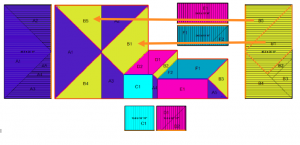
AppliCad has announced Block-Cut panel optimization tools to be launched with the next version of the its Roof Wizard software.
Block-Cut is a new process where the estimator determines where panels/sheets can go and more particularly, where the offcuts can go, as part of a “block” of panels, thus substantially reducing waste material. It takes the blocks created and sub-divides them to show where the off-cut is expected to be extracted from and applied to the roof.
This is actually taking what roofers do manually, automating it and completing it so quickly that various options may be explored to achieve the best fit. Those roofers who reduce waste by flipping sheets around on hip ends will take to this immediately. It shows them exactly how to achieve the best fit. This is done in the office, before getting to the job site.
Indeed, it is done at quotation stage, allowing full use of offcut material to reduce the costs, improve your competitiveness and increase job profit margins.
The multi-coloured panel placement drawing is sent to the job with the material, and the installation team can see at a glance where every single piece and offcut piece must be placed by colour and section placement code; panel area B1 goes to roof plane area B1, B5 goes to roof plane area B5 etc. This achieves the optimal use of material that might otherwise be offcut waste—almost zero waste in this typical example.
Instead of the average job waste allowance being 10 to 12 percent, you can easily get it to 2 to 5 percent. This can go directly to your bottom line without major retraining and changes to your usual practices. Those not familiar with any attempts to increase profit margin by reducing waste might find this process a little bizarre, but experienced metal roofing guys down-under know and fully appreciate the value of this technique and are excited to have it in the new AppliCad Roof Wizard software. This one new feature could repay the value of the Roof Wizard software in just one moderate sized metal roofing job.




Be the first to comment on "Automate Roofing Waste Reduction with Software’s Panel Optimization Tools"